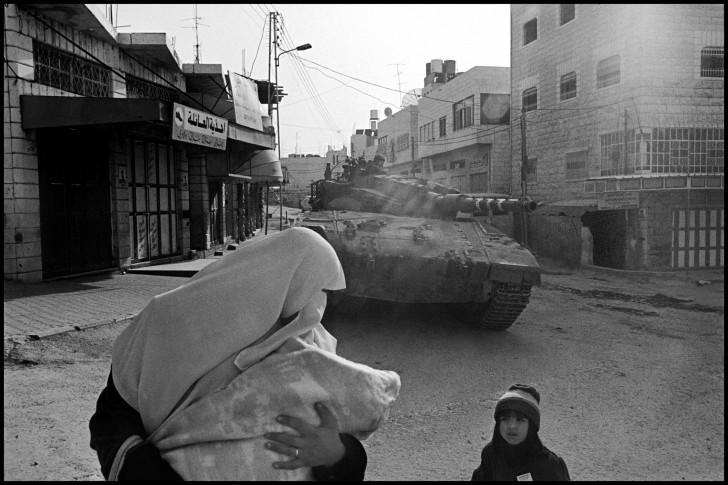79, rue des Archives
75003 Paris
01 40 61 50 50
Venir à la fondation

Award winner 2003
On May 31st , after meetings at the Henri Cartier-Bresson Foundation in Paris, the jury of the HCB Award nominated Larry Towell as the 2003 winner for his project “The walls of no man’s land: Palestine”.
Presented by the Henri Cartier-Bresson Foundation, the HCB Award is a prize of 30 000 Euros to stimulate a photographer’s creativity by offering the opportunity to carry out a project that would otherwise be difficult to achieve.
The HCB Award is made possible by the support of the bank NSMD and NSM Vie (ABN AMRO Group) who reinforce their policy towards contemporary art.
This Award has been given by an International jury composed of 7 distinguished personalities in the world of photography:
Martine Franck: vice-president of the Henri Cartier-Bresson Foundation
Robert Delpire : director of the Henri Cartier-Bresson Foundation
Peter Galassi : curator in chief of photography at the Museum of Modern Art, New York
Marta Gili : responsible for photography and visual arts at Fundacio la Caixa, Barcelona
Roberto Koch : director, Contrasto Milan/Rome
Anne Samson : director of communications, Banque NSMD et NSM Vie
Paul Virilio : philosopher.
“We were very pleased by the high level of portfolios, that were often exceptional” declared the jury. “It was quite difficult to decide, and to eliminate proposals which also deserved recognition. We finally chose Larry Towell, above all for the quality of his work, his personal approach – never seeking the sensational nor exploiting despair. His sensitive eye, his powerful compositions, in the “grand tradition of reportage.”
Paul Virilio remarks that “in this project the analogy with contemporary history is to be underlined; let us not forget that the historical dimension is very much part of the essence of photography”; and Robert Delpire adds “this dimension is also part of the Henri Cartier-Bresson Award”. Marta Gili concludes by saying : “The question of territory is very much a leitmotiv in Larry Towell’s work.”
Project
Larry Towel stated: “I would like to explore the physical and psychological walls that exist between Palestinians and Israelis. I would also like to examine this conflict with a commitment toward a more personal and poetic perception… Intimacy, the antithesis of violence, is much harder to document than war, because it is invisible…”
Biography
Canadian, b. 1953
Larry Towell’s business card reads only “Human Being.” He is also one of those rare photojournalists who, like Robert Doisneau, travels reluctantly and only when the subject is very important to him.
Towell was raised in a large rural family, the son of an autobody repairman. As a teenager his father once scolded him for wanting to drive to Florida with a friend. It was too far from home and he would be corrupted by the distance. While Towell studied visual arts at York University in Toronto (1972 -1976), he was given a camera and taught how to process black-and-white film; and he brought the camera home, because there was no place on earth he wanted to photograph more.
During a stint of volunteer work in Calcutta in 1976, he began photographing and writing, questioning the distribution of wealth, and issues of land and landlessness. When he returned, he supported himself and his family teaching folk music for several years. In 1984, he also became a freelance photographer and writer, focusing on the dispossessed, exile, and peasant rebellion completing projects on the Nicaraguan contra war, the relatives of the “Disappeared” of Guatemala, and US Vietnam veterans who had returned to help rebuild war-damaged Vietnam.
His first published magazine essay, Paradise Lost, was about the ecological consequences of the Exxon Valdez catastrophe in Prince William Sound, Alaska. Experience as a poet in the 1970’s, and as a folk musician in the 1980’s did much to shape his style.
Everywhere he travels he concentrates on intimacy. In 1997 he completed a major story on the Palestinians. In 1996 he completed a project based on ten years of reportage in El Salvador. His fascination with landlessness simultaneously led him to the Mennonite migrant workers of Mexico, a eleven year project. He is currently finishing a reportage of his own family in rural Ontario where he lives and sharecrops a seventy-five acre farm.
Larry has exhibited broadly in Europe and North America and his work is housed in major collections. His reportage has appeared in magazines that include: The New York Times, LIFE, GEO and Stern. Larry has been the recipient of photography Awards that include several World Press and Pictures of the Year Awards, a Eugene Smith, the Oskar Barnak, Roloff Beny, Alfred Eisenstadt, and a Hasselblad Award.
He became a nominee of Magnum in 1988, then a full member in 1993